Topaz Consumer Information
Care
While topaz is quite hard, its toughness and resistance to blows is considered poor because of its perfect directional cleavage. Treated gems may be even more vulnerable to cleaving. Ultrasonic cleaners and steamers should be avoided. A soft, damp cloth remains the best way to clean topaz and topaz jewellery.
Colour is the principal feature of topaz with pink to orange to reddish orange combinations being among the most collectible. Size of the gemstone is also an important attribute, even in irradiated material where huge museum-quality gems are occasionally available.
Treatment
Heating: In some cases, yellow or brown topaz may be changed to pink or red colours
Irradiation / followed by heating: this treatment begins with induced irradiation causing colourless topaz to turn brown or brownish green. A heat treatment follows, turning the material blue. In rare cases, some material may retain residual radioactivity which has generally disappeared before it reaches the end consumer
Color
Topaz occurs in a broad range of colors
Yellow and golden colors are most known for topaz
Topaz sometimes includes a soft blending of pinkish orange to reddish orange colours, which the gem trade has called “imperial topaz”
Natural blue topaz exists but is generally pale
Clarity
Topaz from most sources is reasonably clean and eye-clean stones are both desirable and possible
Pink and red topaz are normally only available in small stones and a slightly higher degree of inclusions are tolerated. These inclusions are usually liquid inclusions
Occasionally trapped minerals such as rutile can be found in topaz.
In very rare cases, tiny ribbon like hollow tubes, forming in parallel fashion, cause cat’s eye effect
Cut
Topaz has perfect cleavage in one direction, so carvings are rare. When they do occur, especially by known artists, they are soon collected.


